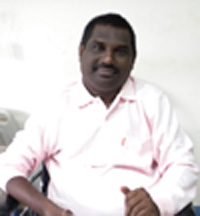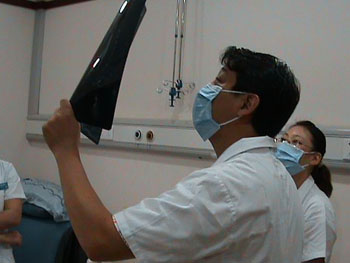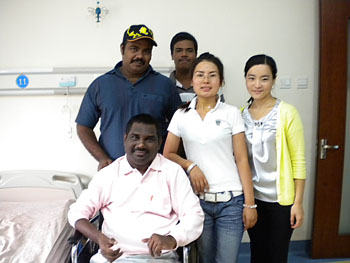Kanavathipillai-Spinal Cord Injury (Sri Lanka) Posted on September 30, 2009
Name: Kanavathipillai Kesavapillai 
Gender: Male
Age: 43
Country: Sri Lanka
Diagnosis: Post trauma spinal cord injury sequela (C5-C7)
Admission Date: 2009-07-29
Date of Discharge: 2009-09-02
Medical History:
Kanavathipillai had a traffic accident on April 6, 2003. After the accident, he was paralyzed. He lost movement in all four limbs and lost his sensory functioning. He had a cervical vertebra surgical operation on April 17, 2003. Three months later, he had another surgical operation on his cervical spinal cord. However, the movement in all four limbs and his sensory functioning remained poor. He received a cystostomy surgical operation in 2004.
Before Treatment:
Kanavathipillai's mental status was poor. He was unable to exercise so his blood circulation was slower than normal. His body temperature was lower than normal. He sweated significantly above the injured area. The strength in both arms was poor, and he could only move them slightly. The fingers in both hands were stuck in a curled position. His fingers were unable to stretch naturally and could not grasp objects. He lost motor ability in both legs. He lost feeling completely below the damaged area of the spinal cord. He was unable to control his urination or bowel movements. As a result of being bedridden, he had developed bedsores.
Treatment:
Kanavathipillai received relevant examinations and was diagnosed with post trauma spinal cord injury sequela. (C5-C7) He was given treatment in order to expand the blood vessels, nourish the neurons, activate the neural stem cells, and this treatment was combined with rehabilitation.
After Treatment:
The muscle strength in both arms increased noticeably. He can now lift his arms, and touch his head with his hands. If the patient focuses hard enough, he can stretch his fingers slightly and hold some small things. He can wipe away sweat with a towel. He is able to hold onto the edge of the bed and stand up by himself. There is obvious independent movement in the left leg and when the doctor asks him to raise the left leg; he is occasionally able to do this. The muscle contractions in his right leg have significantly improved. Above the damaged area, the sweating has been reduced slightly. The sensation of pain has decreased two stages from before (from C3-C5). The abdominal reflex and cremasteric reflex are more sensitive than before. He has some control over his urination and bowel movements. The bedsores have largely healed.


